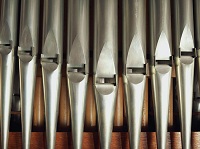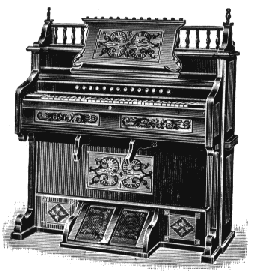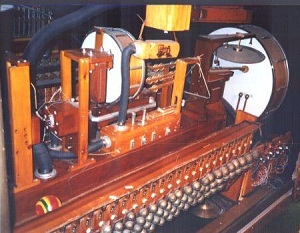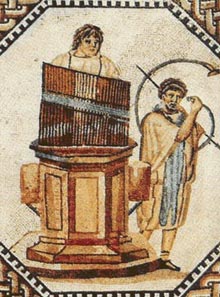 |
Interesting Articles about Popular Topics |
|
|
Dave Carlson - July 11, 2013 An organ is a musical instrument that has been around in one form or another for many centuries. A common characteristic of an organ is the presence of a keyboard for the hands and pedal board for the feet. Some organs are portable, while others are integrated into the framework of a building. There are at least four unique types of organs:
Most historians credit the Greeks with inventing the organ (organon) during the 3rd century BC (estimated around 246 BC). It was a hydraulic pipe organ that used water pressure to force air through pipes and create sounds. By the 8th century, the organ had grown from a curiosity device into a major addition to churches and royal palaces. As the organ grew in popularity, it also grew in size. Ctesibius' original design had evolved from a combination water and air pressure to be exclusively powered by air pressure. The original design required a pump for the water and a bellows for the air. One person operated both the pump and bellows, while another person operated the music controls. The controls were a variation of keyboard and pedals used to direct the air pressure to various pipes to produce the sounds. By the 8th century, organ design required many more people to play a song. Winchester Cathedral had an organ, built in 951, that contained 400 pipes and twenty-six air bellows. While a single talented person could play the organ, it took a team of about seventy men to take turns operating all the bellows to produce enough continuous air pressure to complete a song. It was exhausting work for a single man to pull up and press down on each set of bellows to produce continuous air pressure for the pipes. Each man could continue for only for a short time, so the men worked in complicated coordinated relays. Eventually, someone discovered that if they weighted the bellows it would require no human work to press out the air. Forcing the air out of the billows was the most exhausting part of the work, since the pressurized air needed to be channeled through the pipes. It was much easier for the blower operator merely to raise the upper board and let the weights press the billows down. It is amazing that this ah-ha moment occurred about 800 years later in the sixteenth century. In 1762 a clock-maker named Cummings invented a square, weighted bellows for the organ. This bellows served as an air reservoir and was supplied by other bellows called "feeders." This arrangement allowed several small feeder bellows to supply enough air to keep the primary bellows under continual pressure. Organ musicians used levers, valves, and stops sent the pressurized air jets to the appropriate pipes. 
Solving the problem of delivering enough air pressure for continuous pipe sounds created a new problem for the organ musician (player). Because of the greater air pressure, it took a greater effort to operate the valves that released air to the pipes. And, the bigger the pipe, the more air it took to create the desired effect of a loud low sound. It became such a problem that organ players had to pound on the valves with their fist, instead of just pressing with their fingers. Most songs were played with only one or a few notes at a time -- there was no option to play polyphonic chords with these early organs. A major organ design breakthrough came in 1832. An Englishman named Barker invented a method to use stored air pressure to assist with its own release. A French organ builder, Cavaillé-Coll, worked with Barker to build a more modern organ in 1841. This new design allowed the organ player to press on a key that opened a series of valves which released enough air pressure to activate the associated billows. Eventually, Barker’s original design was modified to include pistons to activate valves, sliders, and stops. By the end of the 19th century, organs resembled the pipe organs we know today. Each of these great breakthroughs allowed organ composers to create new songs to take advantage of the greater capabilities of the organ. Because of the complexity of modern pipe organs, they were accessible only to those who could afford the great expense of constructing and maintaining the organ and the building in which it was housed. Construction included pipes, hoses, valves, bellows, power systems (air, water, steam, electric, etc.), keyboards, and pedals. Pipe organs require continuous work to maintain physical condition and musical quality of the instrument. During the Middle Ages, organ designers developed an organ called a portive organ. It was a small pipe organ that could be carried. They were used by musicians supporting celebrations and special events in royal courts. Because of the inability to create a loud sound, limited octave capabilities, and maintenance requirements this type of organ rarely evolved past the basic design. There was a requirement for a lower maintenance musical instrument that was available to the public. This requirement gave birth to the invention of a reed organ. 
A Frenchman named Alexandre Debain provided a more portable solution in 1840. On August 9, 1840, he patented a reed organ device named the Harmonium. This instrument used a pressure system to provide wind for free reeds instead of pipes. At about the same time, and American developed a free reed instrument, generally referred to as the American Organ. The difference between the French and American versions was that the French version used pressure to push wind over the reeds, while the American version used suction to pull wind over the reeds. Pressure instruments were produced in Europe, mainly in France. The suction variation was produced mostly in the US and Germany. Because of the design and many principles of physics, pressure reed organs have a stronger sound than suction reed organs, with a softer and weaker sound. Because the suction organs were not able to generate as much sound as the pressure organs, suction instruments were limited mostly to use in family homes. Only about 100 years after its invention, the reed organ (both pressure and suction versions) began to lose popularity. With the development of electronic instruments, organ manufacturers were able to produce more reliable instruments for lower price. Additionally, electronic components were much more robust and reliable than organic or synthetic reeds. As with many other devices during this period, electrons replaced physical components. A theater organ, sometimes called a cinema organ, is similar to a pipe organ. However, instead of just pushing sound through pipes, the organ used various devices to imitate an orchestra. The most common use for theater organs was in the United States where they were installed in movie theaters (thus, the name cinema organ). These instruments were used to provide live background music and sound effects for silent films. In addition to pipes, these mechanical marvels combined pianos, bells, drums, cymbals, sirens, whistles, gongs, and many more creative attachments. 
From 1915 to 1933, there were more than 7,000 theater organs installed in movie theaters throughout the United States. A few theaters in the United Kingdom (at least 261 cinemas and theaters) constructed the organs, but the theater organ never really caught on anywhere other than the US and UK. With the introduction of "talkies" (movies with sound), the theater organ fell out of popularity and quickly moved to other locations, before being relegated to scrap heaps. While several hundred of the instruments are known to still exist, only about 40 remain functional in their original theaters. The organs that remain are impressive and well maintained, since they contained state of the art technology and engineering when they were constructed. Five distinguishing characteristics of a theater organ, which separate it from a traditional pipe organ, are:
As with the reed organ, the demise of the theater organ was hastened by the development of electronic and computer technology. Today, electronic organs far exceed the number of other types of organs in active use. Some people would argue that digital keyboard instruments are not true organs, but the fact remains that they can produce very similar sounds. The first successful completely electric organ was the Hammond organ manufactured in the 1930s. The organs used rotating mechanical tone wheels to produce various sounds. The wheels were controlled by a system of drawbars which produced specific sounds and vibrato-like effects. This early electronic organ became popular in jazz and gospel music. During the 1960s and 1970s the unique organ sound was discovered by rock and roll bands and became a common sound in rock and roll music of that era. The organ sound again regained some popularity with pop music around 2000. The availability of clone wheel organs, often light enough for one person to carry, made it possible for all bands to incorporate the organ sound into their music. Also during the 1960s and 1970s, technology was able to deliver portable electronic organs, called combo organs. These self-contained keyboard devices quickly became a major instrument for rock and pop bands in the 1970s. They were made popular by rock groups like The Doors and Iron Butterfly. Farfisa and Vox produced the most popular keyboard organs. 
In the 1980s, integrated circuit technology generated another explosive revolution for the use of electronic keyboard instruments. This new digital technology allowed the use of sampling to produce sound. Actual sounds were programmed into the digital circuits and used to produce an almost unlimited range of sounds. The industry expanded rapidly, allowing major manufacturers like Baldwin, Johannus, Eminent, Content, Viscount, Makin, Wyvern, Allen Organ, and Rodgers to offer their electronic keyboards to the public. Today digital keyboards are available to anyone who desires to purchase them. These keyboards connect to any form of amplification and offer connections to computers to enhance their capability. Since 1983, many digital keyboards have a Musical Instrument Digital Interface (MIDI) capability. MIDI is a technical standard that describes a protocol, digital interface, and connector standards. It allows a wide variety of electronic musical instruments, computers, and other related devices to connect and communicate with one another. MIDI technology allows a keyboard player to play music that is digitally recorded in a computer. This digital technology allows a single keyboard operator to play up to sixteen tracks and mix those tracks in a computer to produce a complex musical piece. Since about 246 BC, people have been using organ-type instruments to create music. The organ has evolved from an instrument that used pipes and reeds to a fully-digital device to produce music and special sound effects. While there still is a place for traditional massive pipe organs in modern society, the digital keyboard has found its way into almost every musical genre. With a digital keyboard one person can carry, setup, and play, a modern musician which can create more sound variety and depth that a full orchestra and choir combined. Mankind has come a long way from using water-pressure pipes to digital keyboards for creating music. Internet References for Further Study of Organ History:
|
||||
|
 The earliest organ was known as a hydraulus, or organum hydraulicum. The inventor was an engineer and inventor named Ctesibius of Alexandria, who was fascinated with creating things that moved. You can read more about the original hydraulic organ and its metamorphosis into a more modern design as a pneumatic organ at
The earliest organ was known as a hydraulus, or organum hydraulicum. The inventor was an engineer and inventor named Ctesibius of Alexandria, who was fascinated with creating things that moved. You can read more about the original hydraulic organ and its metamorphosis into a more modern design as a pneumatic organ at